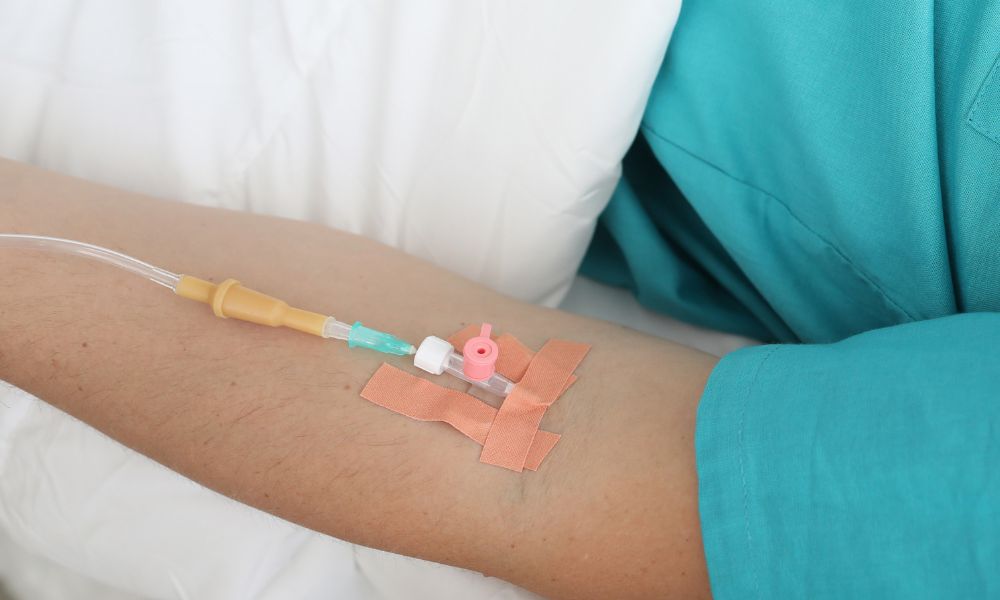A common IV used in healthcare facilities is the peripheral IV. This IV type includes small tubes nurses insert into veins in the arms or hands to simplify medicine, fluid, or nutrient administration. However, beyond that basic understanding, there is more to know about this kind of infusion. By the end of this guide to everything you need to know about peripheral IV, you’ll be ready to succeed in a peripheral IV certification class.
A Deeper Look at Peripheral IVs
When using a peripheral intravenous (IV) line, an infusion nurse takes a short catheter—a thin, flexible tube—and inserts it into a small peripheral vein. Professionals use this line to administer medication and fluids or draw blood samples. Typically, nurses use the peripheral veins in the patient’s hand, arm, or leg for this procedure. The placement of an IV line is among the most common invasive procedures conducted in healthcare settings. Once the line is in, healthcare professionals can inject substances directly into the patient’s bloodstream, ensuring rapid medication distribution throughout the body. It’s important to note that a trained medical professional must place a peripheral IV under sterile conditions to minimize the potential risk of infection.
The Benefits of Peripheral IV
Peripheral IV lines offer several benefits in healthcare settings, including the following.
Rapid Action
The primary advantage of peripheral IV administration is the speed of delivery of medication to the patient’s body. Because the medicine enters the bloodstream, its action time works faster than oral or other routes of administration.
Controlled Administration
With a peripheral IV line in place, healthcare providers have precise control over the dosage and rate of medication, ensuring the patient’s safety and enhancing the effectiveness of treatment.
Flexibility
Peripheral IV lines allow for administering a wide range of substances, including fluids, medication, blood products, and nutritional solutions.
Patient Comfort
While the first insertion might cause minor discomfort, the patient feels no pain during medication processing or the movement of fluid through the line, improving overall patient comfort and experience.
Accessibility
Peripheral veins are easily accessible, making peripheral IV insertion a quick and simple procedure with performance flexibility in various healthcare settings.
Though peripheral IV lines offer many advantages, an untrained healthcare professional should never perform this procedure.
The Complications and Risks of Peripheral IV
Despite the many advantages, using peripheral IV lines is not without potential complications and risks. Professionals refer to these risks as immediate and delayed complications.
Immediate Complications
Immediate complications can happen during or shortly after the insertion of a peripheral IV line, including bleeding, infiltration, phlebitis, and failed insertion. Bleeding can occur at the puncture site, with heavy or persistent bleeding showing potential damage to a larger blood vessel.
Infiltration happens when the IV fluid leaks into the surrounding tissue instead of the vein, causing swelling, discomfort, or a cool sensation around the IV site. Phlebitis, characterized by vein inflammation, typically presents symptoms such as pain, swelling, warmth, and redness at the IV site. Meanwhile, failed insertion can occur due to various factors.
These complications are manageable when promptly identified, highlighting the importance of close patient monitoring during and after peripheral IV line insertion.
Delayed Complications
Delayed complications don’t always immediately follow the insertion of a peripheral IV line, but they could have a significant risk. These complications can include infection, thrombophlebitis, and a dislodged catheter. Infection, characterized by fever, chills, and inflammation around the IV site, can occur when microorganisms gain entry to the body through the IV line.
Thrombophlebitis, or a blood clot in the vein, can develop over time and may cause redness, warmth, and pain along the path of the vein. Lastly, a dislodged catheter can migrate elsewhere in the vein and cause serious complications.
These delayed complications emphasize the importance of repeated patient checks even after successful IV line placement.
How To Minimize Peripheral IV Complications
It is possible to minimize complications when working with peripheral IV lines. You can start by ensuring all employees have proper training. Training teaches healthcare providers how to use peripheral IV insertion and maintenance techniques. For example, workers in Texas hospitals can take the IV certification for Texas to learn to select an insertion site, utilize a proper aseptic technique, and recognize signs of complications.
What Is the Aseptic Technique?
The aseptic technique is a fundamental practice used to prevent or minimize the risk of introducing harmful microorganisms into sterile parts of the body during procedures such as peripheral IV line placement. This method involves using specific practices and processes to keep sterility and prevent the spread of pathogens. The aseptic technique often involves basic hygiene practices, such as washing hands, wearing PPE gear, and sterilizing equipment. Sterilization goes beyond equipment—the training also goes over disinfecting the environment before the procedure, overseeing sterile equipment, and properly disposing of non-sterile items. By adhering to the principles of aseptic technique, healthcare providers help reduce the risk of infection associated with invasive procedures.
What PPE Gear Should Medical Professionals Wear?
Personal Protective Equipment (PPE) ensures medical staff and patients stay safe during the peripheral IV. This equipment is a barrier between healthcare professionals and other infection sources, reducing the risk of cross-contamination.
Below, we provide a rundown of the PPE gear typically needed for peripheral IV infusions.
Gloves
Gloves are an essential piece of PPE. They protect the healthcare provider’s hands from direct contact with the patient’s skin, blood, or body fluids. They also prevent the transfer of microorganisms from the healthcare provider to the patient.
Gowns
Gowns offer protection against splashes or spills that could occur during the procedure. In most scenarios, a clean, non-sterile gown is sufficient. However, workers may need to wear a sterile gown in situations with a higher risk of infection.
Mask and Eye Protection
A mask limits the spread of respiratory droplets that could contaminate the sterile field. In procedures where splashes or sprays are possible, eye protection with a full face shield or mask is a necessity.
Sterile Drape
A sterile drape creates a barrier between the patient’s skin and the non-sterile equipment used during the procedure. Professionals place this drape on the patient before prep and draping begin.
Typical Equipment Used in Peripheral IV Infusions
Peripheral IV infusions rely on specialized equipment such as IV catheters, infusion pumps, and extension sets to ensure safe and effective procedures. These tools enable precise control and correct dosage administration, reducing the risk of complications and maximizing therapeutic benefits. Key equipment includes IV catheters for direct delivery, needles, tourniquets, IV drip chambers, IV bags, IV stands, antiseptic wipes, and adhesive dressings.
Understanding peripheral IV lines is crucial for healthcare professionals, as it enhances patient treatment efficiency. Healthcare professionals can prevent complications and administer medications effectively with the right knowledge and skills by seeking proper training and certifications in IVs. By becoming certified in infusions, you contribute to better patient care. Invest in your skills and boost your healthcare career today for better patient care.








